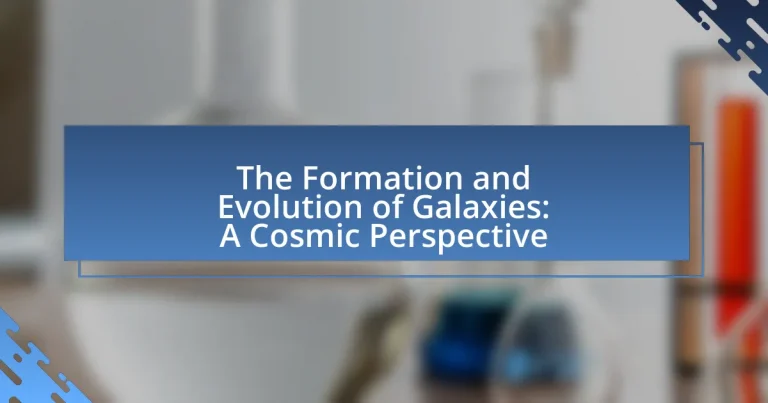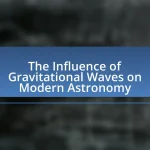Galaxies are vast systems of stars, gas, dust, and dark matter, playing a crucial role in the universe’s structure and evolution. This article explores the formation and evolution of galaxies, detailing the processes that lead to their creation, such as gravitational collapse and the influence of dark matter. It examines the various types of galaxies, their characteristics, and the significance of phenomena like supermassive black holes and active galactic nuclei. Additionally, the article discusses observational techniques used to study galaxies and the practical applications of this research in understanding cosmic phenomena and informing future space exploration.

What are Galaxies and Why are They Important in the Universe?
Galaxies are vast systems composed of stars, stellar remnants, interstellar gas, dust, and dark matter, bound together by gravity. They are crucial in the universe as they serve as the primary sites for star formation and the evolution of cosmic structures. For instance, the Milky Way galaxy, which contains over 100 billion stars, plays a significant role in understanding the lifecycle of stars and the dynamics of cosmic evolution. Additionally, galaxies help astronomers study the distribution of dark matter and the expansion of the universe, as evidenced by observations of galaxy clusters and their redshifts, which provide insights into cosmic history and the fundamental forces shaping the universe.
How do Galaxies Form in the Cosmic Landscape?
Galaxies form through the gravitational collapse of gas and dark matter in the cosmic landscape. Initially, small density fluctuations in the early universe led to the accumulation of matter, which then coalesced under gravity to create protogalaxies. These protogalaxies continued to merge and evolve, driven by gravitational interactions and the cooling of gas, resulting in the diverse structures observed today. Observational evidence, such as the Cosmic Microwave Background radiation and simulations of large-scale structure formation, supports this process, demonstrating how galaxies emerged from the primordial conditions of the universe.
What are the Initial Conditions for Galaxy Formation?
The initial conditions for galaxy formation include the presence of dark matter, gas density fluctuations, and the expansion of the universe. Dark matter provides the gravitational framework necessary for galaxies to form, while gas density fluctuations lead to regions of higher density that can collapse under gravity. The expansion of the universe influences the rate at which these structures evolve. These conditions are supported by observations of the cosmic microwave background radiation, which indicates the density variations in the early universe, and simulations that show how these factors contribute to the formation of galaxies over time.
How do Gas and Dark Matter Contribute to Galaxy Formation?
Gas and dark matter are fundamental components in the process of galaxy formation. Gas, primarily hydrogen and helium, cools and condenses under gravity, forming stars and galaxies. Dark matter, which constitutes about 27% of the universe’s mass-energy content, provides the gravitational framework that influences the motion of visible matter, guiding the accumulation of gas into denser regions where galaxies can form. Observations show that galaxies are often found in clusters where dark matter is concentrated, indicating its role in shaping the large-scale structure of the universe. The interplay between the gravitational pull of dark matter and the cooling processes of gas is crucial for the formation of galaxies, as evidenced by simulations and studies of cosmic microwave background radiation, which reveal the distribution of dark matter and its impact on galaxy formation.
What Processes Drive the Evolution of Galaxies?
The processes that drive the evolution of galaxies include gravitational interactions, star formation, supernova explosions, and mergers with other galaxies. Gravitational interactions between galaxies can lead to tidal forces that reshape their structures and trigger star formation. Star formation occurs when gas and dust collapse under gravity, leading to the birth of new stars, which can significantly alter a galaxy’s luminosity and chemical composition. Supernova explosions from massive stars enrich the interstellar medium with heavy elements, influencing subsequent star formation. Additionally, mergers between galaxies can result in the formation of larger galaxies and can dramatically change their morphology and dynamics. These processes are supported by observational evidence, such as the discovery of interacting galaxies and the correlation between galaxy mergers and starburst activity, as documented in studies like “The Role of Mergers in Galaxy Evolution” by Conselice et al. (2009).
How do Stellar Evolution and Supernovae Influence Galaxies?
Stellar evolution and supernovae significantly influence galaxies by contributing to the chemical enrichment of the interstellar medium and triggering star formation. As stars evolve, they produce heavier elements through nuclear fusion, which are released into space during supernova explosions. This process enriches the surrounding gas and dust, providing the necessary materials for new stars and planetary systems. For instance, supernovae can create shock waves that compress nearby gas clouds, leading to increased star formation rates. Observations show that regions with recent supernova activity often exhibit higher densities of young stars, demonstrating the direct impact of these stellar phenomena on galactic evolution.
What Role do Mergers and Interactions Play in Galaxy Evolution?
Mergers and interactions play a crucial role in galaxy evolution by significantly altering their structure, star formation rates, and overall dynamics. When galaxies collide, they can trigger bursts of star formation due to the gravitational forces involved, leading to the creation of new stars and the redistribution of gas and dust. For example, the merger of the Milky Way with the Andromeda Galaxy, projected to occur in about 4.5 billion years, is expected to result in a new galaxy formation, demonstrating how such interactions can reshape galactic structures. Additionally, studies have shown that major mergers can lead to the formation of elliptical galaxies, while minor mergers often contribute to the growth of spiral galaxies. This evidence highlights the fundamental impact of mergers and interactions on the evolutionary pathways of galaxies.
Why is Understanding Galaxy Formation and Evolution Crucial for Cosmology?
Understanding galaxy formation and evolution is crucial for cosmology because it provides insights into the structure and history of the universe. Galaxies are the fundamental building blocks of the cosmos, and their formation processes reveal the conditions of the early universe, including the distribution of dark matter and the influence of cosmic inflation. Research indicates that the study of galaxy evolution helps explain phenomena such as the cosmic microwave background radiation and the large-scale structure of the universe, which are essential for validating cosmological models. For instance, observations from the Hubble Space Telescope have shown how galaxies evolve over billions of years, allowing scientists to trace the timeline of cosmic history and understand the role of various forces in shaping the universe.
How do Galaxies Help Us Understand the Structure of the Universe?
Galaxies help us understand the structure of the universe by serving as fundamental building blocks that reveal the distribution of matter and the dynamics of cosmic evolution. Their formation and clustering patterns indicate the presence of dark matter, as galaxies are often found in groups or clusters that align with the gravitational influence of unseen mass. Observations of galaxy redshifts provide insights into the expansion of the universe, supporting the Big Bang theory and allowing astronomers to map the large-scale structure of the cosmos. Additionally, the study of galaxy morphology and composition informs us about the processes of star formation and the lifecycle of matter, illustrating how galaxies evolve over time.
What Insights do Galaxies Provide About Dark Matter and Dark Energy?
Galaxies provide critical insights into dark matter and dark energy through their gravitational effects and large-scale structure. Observations of galaxy rotation curves reveal that visible matter alone cannot account for the observed speeds, indicating the presence of dark matter, which constitutes approximately 27% of the universe’s mass-energy content. Additionally, the distribution of galaxies in clusters and the cosmic web structure supports the existence of dark energy, which is responsible for the accelerated expansion of the universe, making up about 68% of the total energy density. Studies, such as those from the Sloan Digital Sky Survey, have mapped galaxy distributions and provided evidence for these phenomena, reinforcing our understanding of dark matter and dark energy’s roles in cosmic evolution.

What are the Different Types of Galaxies?
There are four main types of galaxies: spiral, elliptical, irregular, and lenticular. Spiral galaxies, such as the Milky Way, feature a flat, rotating disk containing stars, gas, and dust, along with a central concentration of stars known as the bulge. Elliptical galaxies, which range from nearly spherical to elongated shapes, contain older stars and little interstellar matter, making them less active in star formation. Irregular galaxies lack a distinct shape and often contain young stars and significant amounts of gas and dust, leading to ongoing star formation. Lenticular galaxies exhibit characteristics of both spiral and elliptical galaxies, possessing a central bulge and a disk but lacking prominent spiral arms. These classifications are supported by the Hubble sequence, which categorizes galaxies based on their morphological features.
How are Galaxies Classified Based on Their Morphology?
Galaxies are classified based on their morphology into three primary categories: spiral, elliptical, and irregular. Spiral galaxies, characterized by their distinct arms winding outward from a central bulge, often contain significant amounts of gas and dust, facilitating star formation. Elliptical galaxies, ranging from nearly spherical to elongated shapes, typically have older stars and minimal gas, indicating low star formation activity. Irregular galaxies lack a defined shape and often result from gravitational interactions or collisions with other galaxies, showcasing diverse structures and star formation rates. This classification system, established by Edwin Hubble in the early 20th century, is foundational in understanding galaxy evolution and structure.
What are the Characteristics of Spiral Galaxies?
Spiral galaxies are characterized by their distinct spiral arms that wind outward from the center, creating a flat, rotating disk structure. These galaxies typically contain a central bulge composed of older stars, surrounded by a disk filled with younger stars, gas, and dust. The presence of these spiral arms is due to density waves that trigger star formation, leading to the bright, blue regions often observed in these galaxies. Additionally, spiral galaxies often exhibit a significant amount of dark matter, which influences their rotation curves and overall mass distribution. Observational data from telescopes, such as the Hubble Space Telescope, supports these characteristics, revealing the structure and composition of numerous spiral galaxies in the universe.
What Defines Elliptical and Irregular Galaxies?
Elliptical galaxies are defined by their smooth, featureless light profiles and elliptical shapes, lacking significant structure such as spiral arms. They primarily consist of older stars and have little to no ongoing star formation. In contrast, irregular galaxies are characterized by their chaotic, asymmetric shapes and lack of a defined structure, often containing young stars and active star formation regions. The distinction between these galaxy types is supported by observational data from telescopes, which show that elliptical galaxies typically have redder colors due to their older stellar populations, while irregular galaxies exhibit bluer colors indicative of younger stars.
What are the Key Features of Active Galactic Nuclei?
Active Galactic Nuclei (AGN) are characterized by their extremely luminous emissions, often outshining their host galaxies. These emissions arise from accretion of material onto supermassive black holes at the centers of galaxies, leading to the release of vast amounts of energy across the electromagnetic spectrum, including radio, optical, ultraviolet, and X-ray wavelengths. AGN exhibit variability in brightness over time, indicating dynamic processes at play, and they can be classified into different types, such as Seyfert galaxies and quasars, based on their spectral characteristics and luminosity. The presence of jets and outflows, which can extend thousands of light-years, is another key feature, influencing the surrounding intergalactic medium and galaxy evolution.
How do Supermassive Black Holes Affect Galaxy Dynamics?
Supermassive black holes significantly influence galaxy dynamics by acting as gravitational anchors that affect the motion of stars and gas within galaxies. Their immense mass, often millions to billions of times that of the Sun, creates a strong gravitational field that can stabilize or destabilize the orbits of surrounding stars and gas clouds. For instance, in the Milky Way, the supermassive black hole Sagittarius A* plays a crucial role in the orbital dynamics of stars in its vicinity, leading to the formation of a dense stellar cluster around it. Additionally, supermassive black holes can drive galactic evolution through feedback mechanisms, such as active galactic nuclei, which can regulate star formation by expelling gas from the galaxy. This interplay between black holes and galaxy dynamics is supported by observations from various studies, including those from the Event Horizon Telescope, which provided direct imaging of the black hole in M87, illustrating its impact on the surrounding galaxy.
What is the Significance of Quasars in Galaxy Studies?
Quasars are significant in galaxy studies because they serve as indicators of the early universe and the formation of galaxies. These extremely luminous objects, powered by supermassive black holes at the centers of distant galaxies, provide insights into the conditions and processes that existed when galaxies were forming. Observations of quasars reveal information about the distribution of matter in the universe, the rate of star formation, and the evolution of galaxies over cosmic time. For instance, the light from quasars allows astronomers to study the intergalactic medium and the growth of structures in the universe, as their brightness can outshine entire galaxies, making them visible across vast distances.

What Observational Techniques are Used to Study Galaxies?
Astronomers use various observational techniques to study galaxies, including optical imaging, spectroscopy, radio observations, and infrared observations. Optical imaging captures light from galaxies, allowing for the analysis of their structure and morphology. Spectroscopy provides information about the composition, temperature, and motion of stars and gas within galaxies by analyzing the light spectrum. Radio observations detect emissions from neutral hydrogen and other molecules, revealing details about galaxy formation and dynamics. Infrared observations penetrate dust clouds, enabling the study of star formation and the detection of cooler objects. These techniques collectively enhance our understanding of galaxy formation and evolution.
How do Telescopes and Instruments Capture Galaxy Data?
Telescopes and instruments capture galaxy data by utilizing various technologies to detect and analyze electromagnetic radiation emitted by galaxies. Optical telescopes collect visible light through lenses or mirrors, while radio telescopes capture radio waves using large dish antennas. Instruments like spectrographs analyze the light’s spectrum, revealing information about a galaxy’s composition, temperature, and motion. For instance, the Hubble Space Telescope has provided detailed images and spectra of distant galaxies, allowing astronomers to study their formation and evolution over billions of years. This data is crucial for understanding the universe’s structure and the processes that govern galaxy formation.
What Role do Optical and Radio Telescopes Play in Galaxy Research?
Optical and radio telescopes are essential tools in galaxy research, enabling astronomers to observe and analyze galaxies across different wavelengths. Optical telescopes capture visible light, allowing for the study of stellar populations, galaxy morphology, and the effects of dust and gas on light emission. For instance, the Hubble Space Telescope has provided detailed images of galaxy structures and star formation regions, revealing insights into galaxy evolution.
Conversely, radio telescopes detect radio waves emitted by cold gas and cosmic phenomena, facilitating the study of galaxy dynamics, gas distribution, and interactions between galaxies. The Very Large Array has been instrumental in mapping the distribution of hydrogen gas in galaxies, which is crucial for understanding star formation processes. Together, these telescopes provide a comprehensive view of galaxies, contributing significantly to our understanding of their formation and evolution.
How do Space-Based Observatories Enhance Our Understanding of Galaxies?
Space-based observatories enhance our understanding of galaxies by providing unobstructed views of the universe, allowing for detailed observations across various wavelengths, including ultraviolet, optical, and infrared. These observatories, such as the Hubble Space Telescope and the James Webb Space Telescope, can capture high-resolution images and spectra of galaxies, revealing their structure, composition, and dynamics. For instance, Hubble’s observations have led to the discovery of the relationship between galaxy formation and dark matter, while the James Webb Space Telescope’s infrared capabilities allow scientists to study the formation of stars and galaxies in the early universe. This data is crucial for testing and refining cosmological models, ultimately deepening our comprehension of galaxy evolution and the large-scale structure of the universe.
What are the Challenges in Observing Distant Galaxies?
The challenges in observing distant galaxies include their faintness, redshift, and the interference of cosmic dust. Distant galaxies emit less light, making them difficult to detect with current telescopes; for instance, the light from galaxies billions of light-years away is often too weak to be captured effectively. Additionally, as light travels through the expanding universe, it experiences redshift, shifting wavelengths toward the red end of the spectrum, which complicates the analysis of their composition and distance. Cosmic dust also obscures the view of these galaxies, absorbing and scattering light, which can lead to misinterpretations of their properties. These factors collectively hinder astronomers’ ability to study the formation and evolution of galaxies accurately.
How do Redshift and Cosmic Expansion Affect Observations?
Redshift and cosmic expansion significantly affect astronomical observations by altering the wavelengths of light emitted from distant celestial objects. As the universe expands, light from these objects stretches, resulting in redshift, which indicates that they are moving away from us. This phenomenon allows astronomers to determine the velocity and distance of galaxies, providing insights into the universe’s expansion rate, as evidenced by Hubble’s Law, which states that the recessional velocity of galaxies is proportional to their distance from Earth. Consequently, redshift measurements are crucial for understanding the large-scale structure and evolution of the universe, including the formation and distribution of galaxies over cosmic time.
What Techniques are Used to Overcome Observational Limitations?
Techniques used to overcome observational limitations in the study of galaxy formation and evolution include adaptive optics, multi-wavelength observations, and computer simulations. Adaptive optics corrects distortions caused by Earth’s atmosphere, allowing telescopes to capture clearer images of distant galaxies. Multi-wavelength observations utilize data from various parts of the electromagnetic spectrum, such as radio, infrared, and X-rays, to provide a more comprehensive understanding of galaxy properties and behaviors. Computer simulations model complex processes in galaxy formation, enabling researchers to test hypotheses and predict outcomes based on physical laws. These techniques collectively enhance the accuracy and depth of astronomical observations, facilitating a better understanding of cosmic phenomena.
What Practical Applications Arise from Studying Galaxy Formation and Evolution?
Studying galaxy formation and evolution has practical applications in understanding the universe’s structure and the origins of cosmic phenomena. This knowledge aids in the development of advanced astronomical models, which can predict the behavior of galaxies and their interactions. For instance, insights gained from galaxy evolution inform simulations that help astronomers understand dark matter’s role in cosmic structure, as evidenced by the Lambda Cold Dark Matter model, which accurately describes the large-scale structure of the universe. Additionally, this research contributes to the field of cosmology, enhancing our comprehension of the universe’s expansion and the Big Bang theory, thereby influencing technologies such as satellite communications and GPS systems that rely on precise astronomical measurements.
How can Insights from Galaxy Studies Inform Future Space Exploration?
Insights from galaxy studies can significantly inform future space exploration by enhancing our understanding of cosmic structures and the conditions necessary for life. Research indicates that the formation and evolution of galaxies reveal critical information about the distribution of elements, the presence of habitable zones, and the potential for life-supporting environments. For instance, studies of the Milky Way and other galaxies have shown that regions with high metallicity are more likely to host planets with the necessary conditions for life, as these areas contain heavier elements essential for planet formation. Furthermore, understanding the dynamics of galaxy interactions can help identify potential targets for exploration, such as exoplanets in habitable zones around stars in neighboring galaxies. This knowledge is crucial for prioritizing missions and optimizing resource allocation in future space exploration endeavors.
What Technologies Developed from Galaxy Research Benefit Other Fields?
Technologies developed from galaxy research that benefit other fields include advanced imaging techniques, data analysis algorithms, and materials science innovations. Advanced imaging techniques, such as adaptive optics, originally designed to enhance astronomical observations, are now utilized in medical imaging to improve the clarity of images in procedures like endoscopy. Data analysis algorithms, including machine learning methods developed for processing vast amounts of astronomical data, are applied in various sectors, including finance for fraud detection and in healthcare for predictive analytics. Additionally, materials science innovations, such as those derived from studying cosmic dust and its properties, have led to the development of new materials with applications in electronics and nanotechnology. These examples illustrate the cross-disciplinary impact of technologies initially developed for galaxy research.


